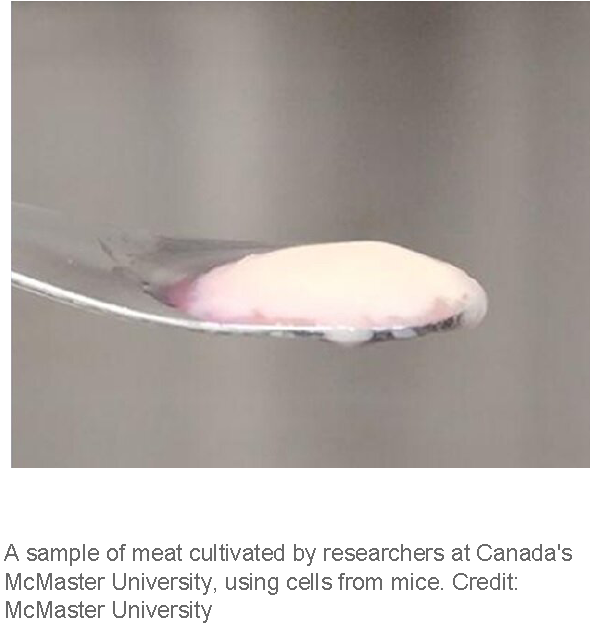博文
加拿大研究者通过细胞工程培育出新型肉品
||
加拿大研究者通过细胞工程培育出新型肉品
诸平


据加拿大麦克马斯特大学(McMaster University)2021年1月19日提供的消息,该大学的研究人员已经开发出一种新型的人工培育肉,使用的方法保证比其他传统动物肉的替代品拥有更天然的风味和质地。相关研究结果于2021年1月13日已经在《细胞-组织-器官》(Cells Tissues Organs)杂志网站发表——Shahin-Shamsabadi A, Selvaganapathy P.R. Engineering Murine Adipocytes and Skeletal Muscle Cells in Meat-like Constructs Using Self-Assembled Layer-by-Layer Biofabrication: A Platform for Development of Cultivated Meat. Cells Tissues Organs (2021). DOI: 10.1159/000511764. Published online: January 13, 2021.
该大学生物医学工程学院(School of Biomedical Engineering)的研究人员Ravi Selvaganapathy和Alireza Shahin-Shamsabadi设计了一种方法,通过在实验室环境中将培养的肌肉和脂肪细胞堆叠在一起来制造肉类。该技术改编自一种用于培养人体移植组织的方法。每片活细胞大约有一张打印纸那么厚,首先在培养皿中培养,然后集中在生长板上,然后剥落并堆叠或折叠在一起。在细胞死亡之前,这些薄片会自然地相互连接。
Ravi Selvaganapathy说,这些层可以堆叠成任何厚度的固体块,并“调整”以复制任何切割肉的脂肪含量和肉脂纹路,这是超过其他肉类替代品的优势所在。他说:“我们正在创造一块块的肉品。消费者将可以购买任意比例脂肪含量的肉,就像购买牛奶一样任意挑选。”
正如他们在《细胞-组织-器官》杂志上发表的文章中所描述的那样,研究人员用可用的老鼠细胞系制造肉来证明这一概念。虽然他们没有吃研究论文中描述的老鼠肉,但他们后来制作并烹煮了一个用兔子细胞制造的肉样本。加拿大麦克马斯特大学的研究人员用老鼠的细胞培育的肉样本(见上面的图片所示)。
Ravi Selvaganapathy说:“它的感觉和味道就像肉。另外也没有理由认为同样的技术不能用于培育牛肉、猪肉或鸡肉等,而且这种模式很适合大规模生产。”
研究人员受到了肉类供应危机的启发,在这一危机中,世界范围内的肉需求正在增长,而当前的肉类消费正在消耗土地和水资源,并产生令人不安的温室气体水平。Ravi Selvaganapathy 认为,“现在的肉类生产是不可持续的,必须有另一种制造肉类的方法。”这样对于保护环境和可持续发展都有益。研究人员指出,在无需繁养动物的情况下生产可行的肉类将更可持续、更卫生、更节约资源。
虽然其他形式的人工肉制品已经被开发出来,但麦克马斯特大学的研究人员认为,他们的人工肉制品最有潜力开发出消费者会接受、享用和负担得起的产品。研究人员已经成立了一家初创公司,开始将这项技术商业化。更多信息请注意浏览原文或者相关报道。
Lab-grown meat to go on sale in Singapore in world first
“Sheets” of Meat Created in the Lab Stack Up Well Against ...
Ideas, Inventions And Innovations : “Sheets” of Meat ...
Researchers create new form of cultivated meat - Tech and ...
New approach to lab-grown meat creates more realistic ... shares
Global meat consumption has been growing on a per capita basis over the past 20 years resulting in ever-increasing devotion of resources in the form of arable land and potable water to animal husbandry which is unsustainable and inefficient. One approach to meet this insatiable demand is to use biofabrication methods used in tissue engineering in order to make skeletal muscle tissue-like constructs known as cultivated meat to be used as a food source. Here, we demonstrate the use of a scaffold-free biofabrication method that forms cell sheets composed of murine adipocytes and skeletal muscle cells and assembles these sheets in parallel to create a 3D meat-like construct without the use of any exogenous materials. This layer-by-layer self-assembly and stacking process is fast (4 days of culture to form sheets and few hours for assembly) and scalable (stable sheets with diameters >3 cm are formed). Tissues formed with only muscle cells were equivalent to lean meat with comparable protein and fat contents (lean beef had 1.5 and 0.9 times protein and fat, respectively, as our constructs) and incorporating adipocyte cells in different ratios to myoblasts and/or treatment with different media cocktails resulted in a 5% (low fat meat) to 35% (high fat meat) increase in the fat content. Not only such constructs can be used as cultivated meat, they can also be used as skeletal muscle models.
https://blog.sciencenet.cn/blog-212210-1268297.html
上一篇:智能手表成为预测COVID-19感染的好帮手
下一篇:有朝一日无负极锌电池可以储存可再生能源